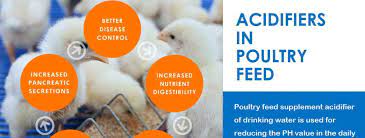Propionic Acid: The Natural Solution for Poultry Growth and Health
Author – Dr Sanjaykumar H. Vaghela
Ph.D. Scholar, Department of Veterinary Pharmacology and Toxicology, College of Veterinary Science and Animal Husbandry, Kamdhenu University, Anand, Gujarat, India.
Introduction
Propionic acid (PA) is a short-chain mono-carboxylic acid that was first described in 1844. It is a naturally occurring compound that is produced by the fermentation of carbohydrates by bacteria in the genus Propionibacterium. PA has a variety of uses, including as a food preservative, animal feed additive, pharmaceutical, and industrial chemical. In the food industry, PA is used as a GRAS (generally recognized as safe) food additive to inhibit the growth of bacteria and mold in foods. It is particularly effective in preventing the growth of mold in cheese, yogurt, and other fermented foods. PA is also used in animal feed as an alternative to antibiotic growth promoters. It has been shown to improve growth, feed efficiency, and gut health in animals. In the pharmaceutical industry, PA is used in some anti-fungal creams and ointments. It is also being investigated for its potential use in treating other conditions, such as autism spectrum disorder and inflammatory bowel disease. In the industrial sector, PA is used in the production of plastics, textiles, and other materials. It is also used as a solvent and a denaturant for alcohol. PA is a safe and effective compound with a wide range of uses. It is a promising alternative to antibiotic growth promoters in animal feed, and it has potential applications in other areas of medicine and industry.
Physicochemical properties of propionic acid
Propionic acid (PA) is a naturally occurring carboxylic acid. It was derived from the Greek words protos= “first” and pion = “fat,” because it was the smallest H (CH2) n COOH acid that exhibited the properties of the other fatty acids, such as producing an oily layer when salted out of water and having a soapy potassium salt. The empirical formula for propionic acid is C3H6O2 with a molecular weight of 74.08 g/moL. In pure state, it is a colorless, liquid with a little unpleasant odour. It is produced biologically in form of its coenzyme-A ester, propionyl-CoA, from the bacteria (Propionibacterium spp.) as the end product of anaerobic metabolism. It has a melting point of -21o C.
Mechanism of action of propionic acid
Propionic acid (PA) is a short-chain fatty acid that has been shown to be an effective alternative to antibiotic growth promoters in poultry. It works by a number of mechanisms, including:
- Inhibiting the growth of pathogenic bacteria:PA is a natural antimicrobial agent that can inhibit the growth of a variety of bacteria, including Salmonella, E. coli, and Campylobacter. This helps to prevent the development of infections in poultry, which can lead to reduced growth and weight gain.
- Improving gut health:PA can help to improve the health of the poultry gut by increasing the number of beneficial bacteria and reducing the number of harmful bacteria. This can lead to better digestion and absorption of nutrients, which can also improve growth and weight gain.
- Reducing stress:PA has been shown to reduce stress in poultry, which can also improve growth and feed efficiency. Stress can lead to decreased appetite and increased metabolism, which can have a negative impact on growth.
- Enhancing immunity:PA can help to enhance the immune system of poultry by increasing the production of white blood cells. This can help to protect poultry from disease and infection.
Propionic acid as growth promoter in poultry
The mechanisms of growth promotion of PA are reduction of pathogenic burden by reducing gut pH, increasing digestibility, improving the permeability of the intestinal mucosa and thus increase in the rate of absorption and also increase in the utilization of protein, amino acids, minerals and other nutrients. Additions of Luprosil® (containing 53.5% PA) @ 0.4% showed significant body weight gain of broiler chicken at 49 days of age compared to unsupplemented group (Izat et al., 1990). Female broilers fed 7.3 kg/ton (0.8%) of Luprosil® (53.5 % PA) resulted in a significant improvement in carcass dressing percentage (Izat et. al., 1990). Significant effect on carcass yield of broiler chicken fed diet supplemented with PA was reported by Hume et al. (1993).
An experiment with organic acid salt (1g/kg each of calcium propionate, ammonium formate and calcium lactate) as substitute for antibiotics (virginiamycin @ 0.5 g/kg as antibiotic) showed numerically higher live weight and live weight gain in organic acid salt supplemented group compared to antibiotic supplemented group (Paul et. al., 2007). Vale et al. (2004) reported that broiler fed organic acid mixture (70% formic acid and 30% PA) @ 0.25 and 0.50% with diet showed higher gain compared to birds fed higher level (1.0 and 2.0%) organic acid mixture. Significant improvement in body weight and weight gain of turkey poult by supplementing MC (Myco curb containing PA) @ 0.625 and 1.25% was reported by Roy et al., (2002). It is well established that PA used as growth promoter improve the rate of utilization of all nutrient especially protein which results better dressing percentage.
Conclusions
Propionic acid is a natural antimicrobial agent that can inhibit the growth of a variety of bacteria, including Salmonella, E. coli, and Campylobacter. It can also help to improve the health of the poultry gut by increasing the number of beneficial bacteria and reducing the number of harmful bacteria. It has been shown to reduce stress in poultry, which can also improve growth and feed efficiency. It can help to enhance the immune system of poultry by increasing the production of white blood cells.


